Abstract
In terms of evolution and fitness, the most significant spontaneous mutation rate is likely to be that for the entire genome (or its nonfrivolous fraction). Information is now available to calculate this rate for several DNA-based haploid microbes, including bacteriophages with single- or double-stranded DNA, a bacterium, a yeast, and a filamentous fungus. Their genome sizes vary by approximately 6500-fold. Their average mutation rates per base pair vary by approximately 16,000-fold, whereas their mutation rates per genome vary by only approximately 2.5-fold, apparently randomly, around a mean value of 0.0033 per DNA replication. The average mutation rate per base pair is inversely proportional to genome size. Therefore, a nearly invariant microbial mutation rate appears to have evolved. Because this rate is uniform in such diverse organisms, it is likely to be determined by deep general forces, perhaps by a balance between the usually deleterious effects of mutation and the physiological costs of further reducing mutation rates.
Full text
PDF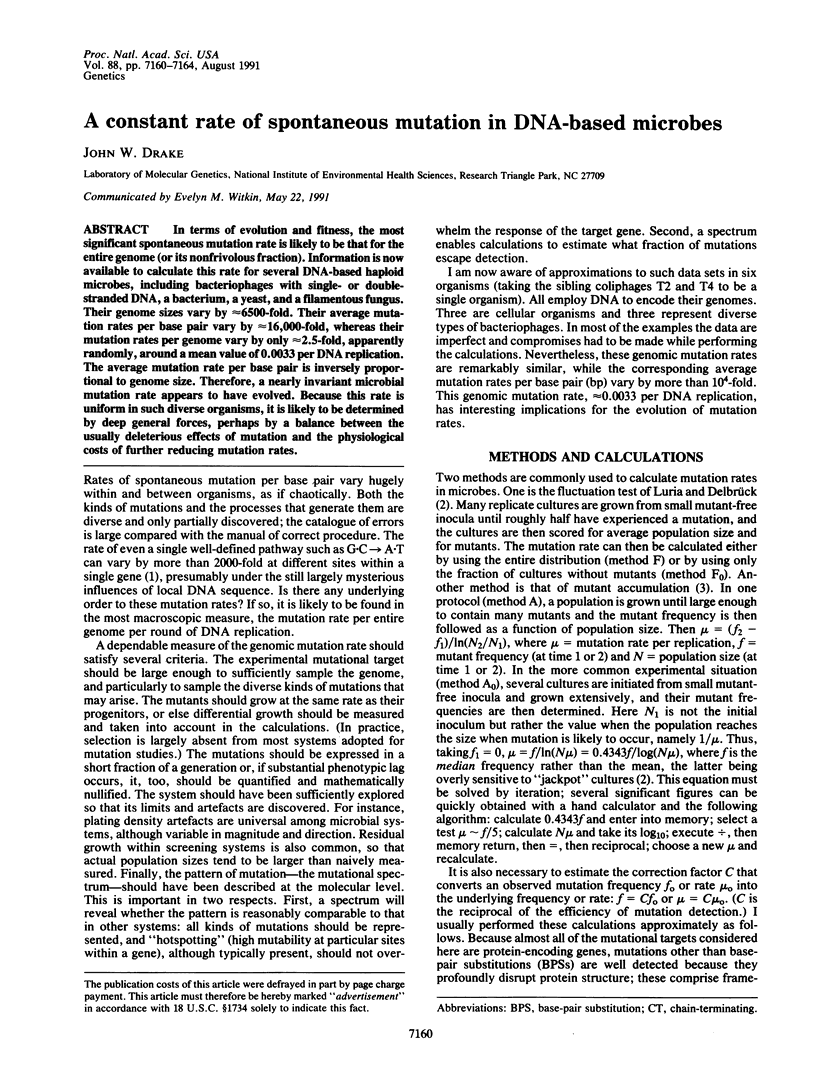
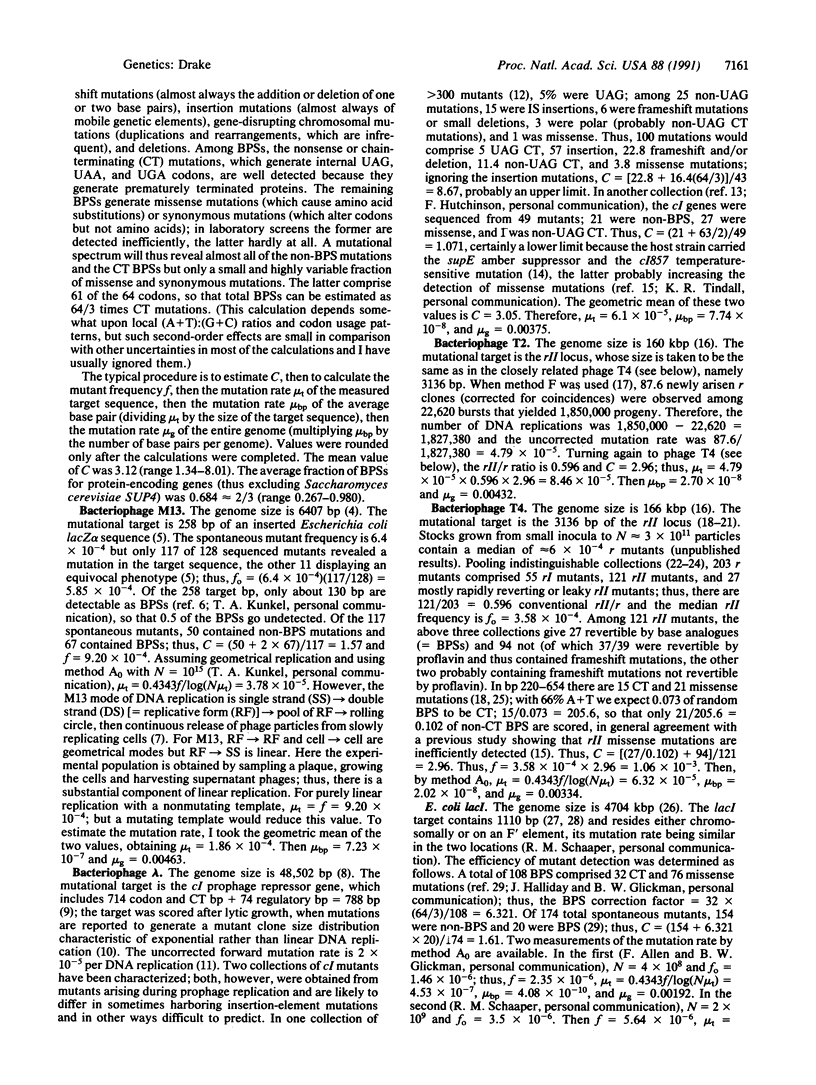
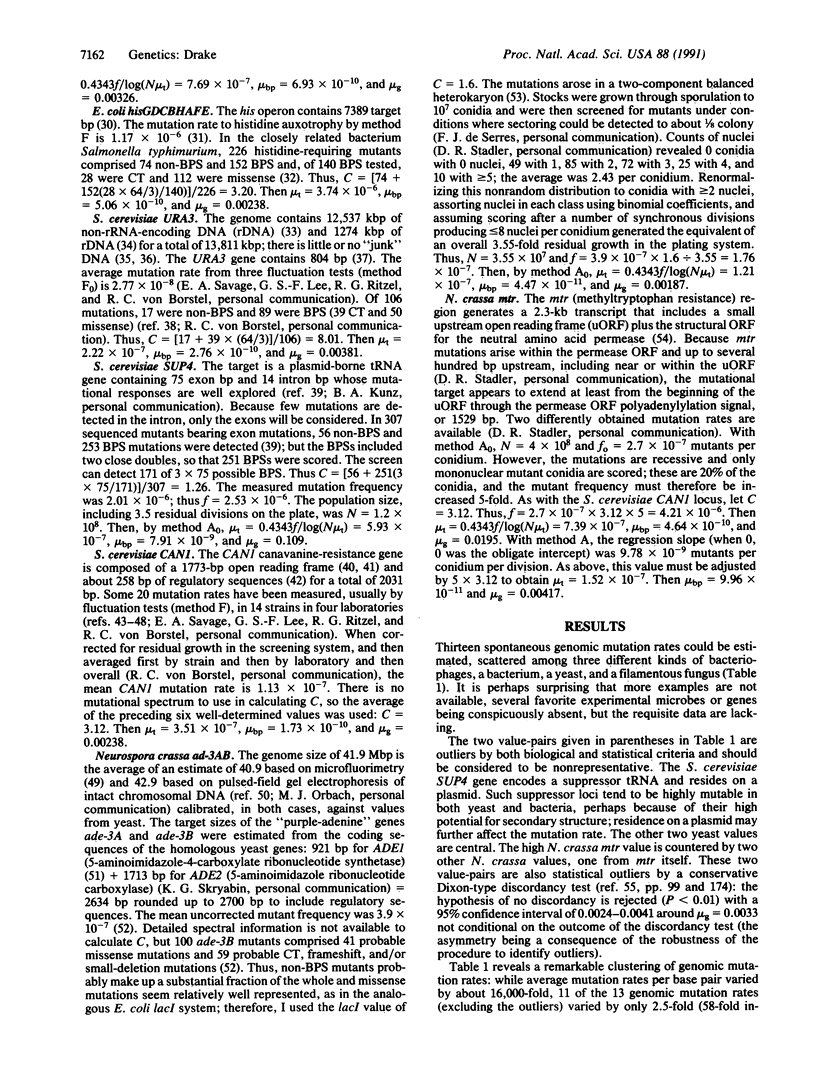
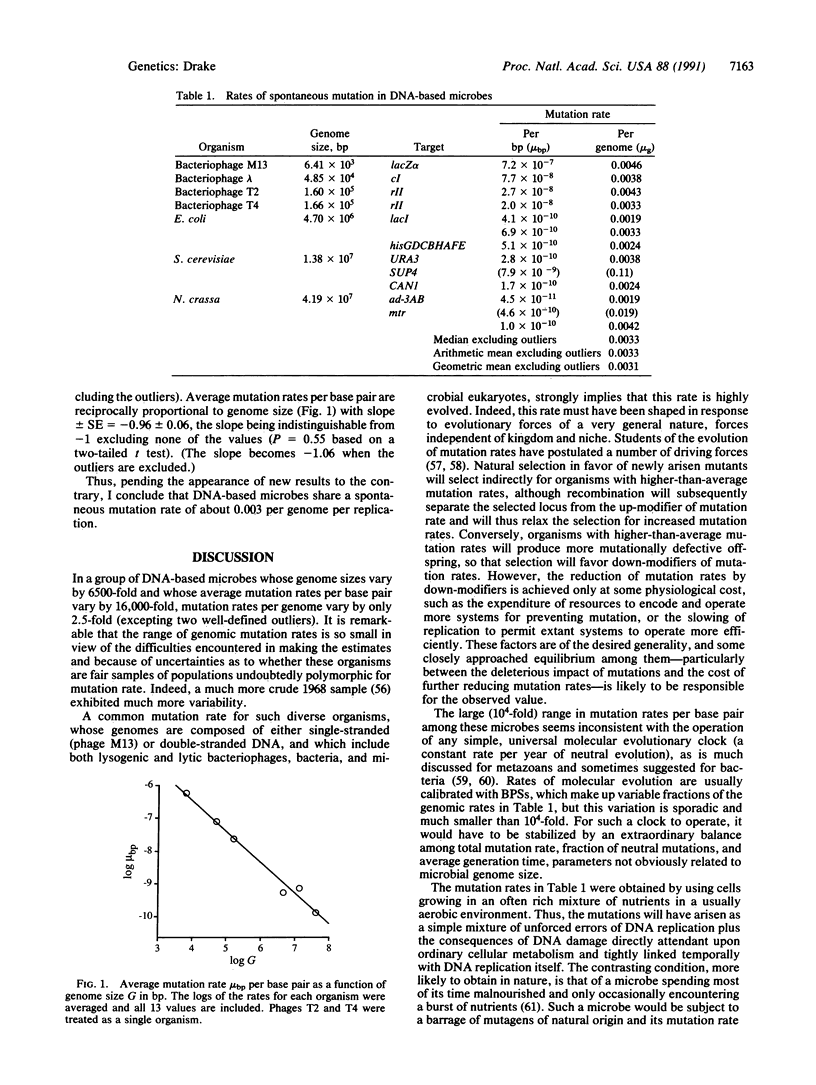
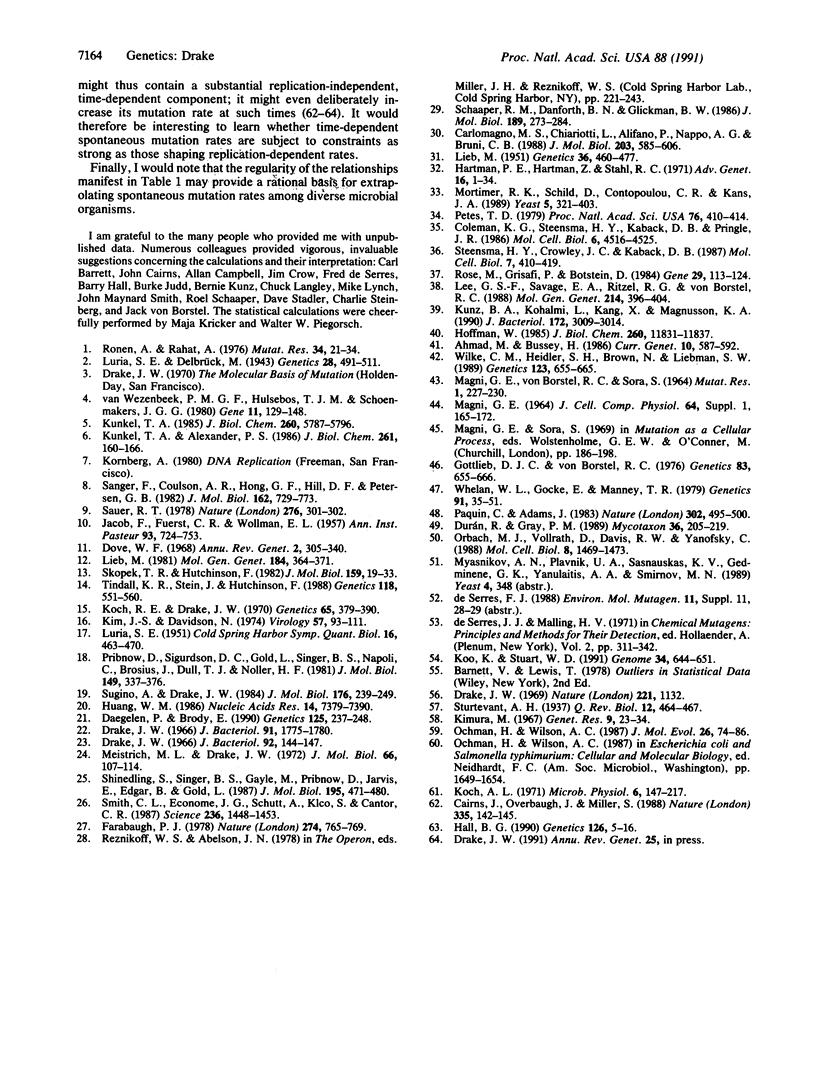
Selected References
These references are in PubMed. This may not be the complete list of references from this article.
- Ahmad M., Bussey H. Yeast arginine permease: nucleotide sequence of the CAN1 gene. Curr Genet. 1986;10(8):587–592. doi: 10.1007/BF00418125. [DOI] [PubMed] [Google Scholar]
- Cairns J., Overbaugh J., Miller S. The origin of mutants. Nature. 1988 Sep 8;335(6186):142–145. doi: 10.1038/335142a0. [DOI] [PubMed] [Google Scholar]
- Carlomagno M. S., Chiariotti L., Alifano P., Nappo A. G., Bruni C. B. Structure and function of the Salmonella typhimurium and Escherichia coli K-12 histidine operons. J Mol Biol. 1988 Oct 5;203(3):585–606. doi: 10.1016/0022-2836(88)90194-5. [DOI] [PubMed] [Google Scholar]
- Coleman K. G., Steensma H. Y., Kaback D. B., Pringle J. R. Molecular cloning of chromosome I DNA from Saccharomyces cerevisiae: isolation and characterization of the CDC24 gene and adjacent regions of the chromosome. Mol Cell Biol. 1986 Dec;6(12):4516–4525. doi: 10.1128/mcb.6.12.4516. [DOI] [PMC free article] [PubMed] [Google Scholar]
- Daegelen P., Brody E. The rIIA gene of bacteriophage T4. I. Its DNA sequence and discovery of a new open reading frame between genes 60 and rIIA. Genetics. 1990 Jun;125(2):237–248. doi: 10.1093/genetics/125.2.237. [DOI] [PMC free article] [PubMed] [Google Scholar]
- Drake J. W., Allen E. F., Forsberg S. A., Preparata R. M., Greening E. O. Genetic control of mutation rates in bacteriophageT4. Nature. 1969 Mar 22;221(5186):1128–1132. [PubMed] [Google Scholar]
- Drake J. W. Ultraviolet mutagenesis in bacteriophage T-4. I. Irradiation of extracellular phage particles. J Bacteriol. 1966 May;91(5):1775–1780. doi: 10.1128/jb.91.5.1775-1780.1966. [DOI] [PMC free article] [PubMed] [Google Scholar]
- Drake J. W. Ultraviolet mutagenesis in bacteriophage T4. II. Photoreversal of mutational lesions. J Bacteriol. 1966 Jul;92(1):144–147. doi: 10.1128/jb.92.1.144-147.1966. [DOI] [PMC free article] [PubMed] [Google Scholar]
- Farabaugh P. J. Sequence of the lacI gene. Nature. 1978 Aug 24;274(5673):765–769. doi: 10.1038/274765a0. [DOI] [PubMed] [Google Scholar]
- Gottlieb D. J., von Borstel R. C. Mutators in Saccharomyces cerevisiae: MUT1-1, MUT1-2 and MUT2-1. Genetics. 1976 Aug;83(4):655–666. doi: 10.1093/genetics/83.4.655. [DOI] [PMC free article] [PubMed] [Google Scholar]
- Hall B. G. Spontaneous point mutations that occur more often when advantageous than when neutral. Genetics. 1990 Sep;126(1):5–16. doi: 10.1093/genetics/126.1.5. [DOI] [PMC free article] [PubMed] [Google Scholar]
- Hartman P. E., Hartman Z., Stahl R. C. Classification and mapping of spontaneous and induced mutations in the histidine operon of Salmonella. Adv Genet. 1971;16:1–34. doi: 10.1016/s0065-2660(08)60352-1. [DOI] [PubMed] [Google Scholar]
- Hoffmann W. Molecular characterization of the CAN1 locus in Saccharomyces cerevisiae. A transmembrane protein without N-terminal hydrophobic signal sequence. J Biol Chem. 1985 Sep 25;260(21):11831–11837. [PubMed] [Google Scholar]
- Huang W. M. The 52-protein subunit of T4 DNA topoisomerase is homologous to the gyrA-protein of gyrase. Nucleic Acids Res. 1986 Sep 25;14(18):7379–7390. [PMC free article] [PubMed] [Google Scholar]
- JACOB F., FUERST R., WOLLMAN E. L. Recherches sur les bactéries lysogènes défectives. II. Les types physiologiques liés aux mutations du prophage. Ann Inst Pasteur (Paris) 1957 Dec;93(6):724–753. [PubMed] [Google Scholar]
- Kim J. S., Davidson N. Electron microscope heteroduplex study of sequence relations of T2, T4, and T6 bacteriophage DNAs. Virology. 1974 Jan;57(1):93–111. doi: 10.1016/0042-6822(74)90111-1. [DOI] [PubMed] [Google Scholar]
- Koch A. L. The adaptive responses of Escherichia coli to a feast and famine existence. Adv Microb Physiol. 1971;6:147–217. doi: 10.1016/s0065-2911(08)60069-7. [DOI] [PubMed] [Google Scholar]
- Koch R. E., Drake J. W. Cryptic mutants of bacteriophage T4. Genetics. 1970 Jul;65(3):379–390. doi: 10.1093/genetics/65.3.379. [DOI] [PMC free article] [PubMed] [Google Scholar]
- Koo K., Stuart W. D. Sequence and structure of mtr, an amino acid transport gene of Neurospora crassa. Genome. 1991 Aug;34(4):644–651. doi: 10.1139/g91-098. [DOI] [PubMed] [Google Scholar]
- Kunkel T. A., Alexander P. S. The base substitution fidelity of eucaryotic DNA polymerases. Mispairing frequencies, site preferences, insertion preferences, and base substitution by dislocation. J Biol Chem. 1986 Jan 5;261(1):160–166. [PubMed] [Google Scholar]
- Kunkel T. A. The mutational specificity of DNA polymerase-beta during in vitro DNA synthesis. Production of frameshift, base substitution, and deletion mutations. J Biol Chem. 1985 May 10;260(9):5787–5796. [PubMed] [Google Scholar]
- Kunz B. A., Kohalmi L., Kang X. L., Magnusson K. A. Specificity of the mutator effect caused by disruption of the RAD1 excision repair gene of Saccharomyces cerevisiae. J Bacteriol. 1990 Jun;172(6):3009–3014. doi: 10.1128/jb.172.6.3009-3014.1990. [DOI] [PMC free article] [PubMed] [Google Scholar]
- LURIA S. E. The frequency distribution of spontaneous bacteriophage mutants as evidence for the exponential rate of phage reproduction. Cold Spring Harb Symp Quant Biol. 1951;16:463–470. doi: 10.1101/sqb.1951.016.01.033. [DOI] [PubMed] [Google Scholar]
- Lee G. S., Savage E. A., Ritzel R. G., von Borstel R. C. The base-alteration spectrum of spontaneous and ultraviolet radiation-induced forward mutations in the URA3 locus of Saccharomyces cerevisiae. Mol Gen Genet. 1988 Nov;214(3):396–404. doi: 10.1007/BF00330472. [DOI] [PubMed] [Google Scholar]
- Lieb M. A fine structure map of spontaneous and induced mutations in the lambda repressor gene, including insertions of IS elements. Mol Gen Genet. 1981;184(3):364–371. doi: 10.1007/BF00352506. [DOI] [PubMed] [Google Scholar]
- Lieb M. Forward and Reverse Mutation in a Histidine-Requiring Strain of Escherichia Coli. Genetics. 1951 Sep;36(5):460–477. doi: 10.1093/genetics/36.5.460. [DOI] [PMC free article] [PubMed] [Google Scholar]
- Luria S. E., Delbrück M. Mutations of Bacteria from Virus Sensitivity to Virus Resistance. Genetics. 1943 Nov;28(6):491–511. doi: 10.1093/genetics/28.6.491. [DOI] [PMC free article] [PubMed] [Google Scholar]
- MAGNI G. E., VONBORSTEL R. C., SORA S. MUTAGENIC ACTION DURING MEIOSIS AND ANTIMUTAGENIC ACTION DURING MITOSIS BY 5-AMINOACRIDINE IN YEAST. Mutat Res. 1964 Oct;106:227–230. doi: 10.1016/0027-5107(64)90003-x. [DOI] [PubMed] [Google Scholar]
- Meistrich M. L., Drake J. W. Mutagenic effects of thymine dimers in bacteriophage T4. J Mol Biol. 1972 Apr 28;66(1):107–114. doi: 10.1016/s0022-2836(72)80009-3. [DOI] [PubMed] [Google Scholar]
- Mortimer R. K., Schild D., Contopoulou C. R., Kans J. A. Genetic map of Saccharomyces cerevisiae, edition 10. Yeast. 1989 Sep-Oct;5(5):321–403. doi: 10.1002/yea.320050503. [DOI] [PubMed] [Google Scholar]
- Ochman H., Wilson A. C. Evolution in bacteria: evidence for a universal substitution rate in cellular genomes. J Mol Evol. 1987;26(1-2):74–86. doi: 10.1007/BF02111283. [DOI] [PubMed] [Google Scholar]
- Orbach M. J., Vollrath D., Davis R. W., Yanofsky C. An electrophoretic karyotype of Neurospora crassa. Mol Cell Biol. 1988 Apr;8(4):1469–1473. doi: 10.1128/mcb.8.4.1469. [DOI] [PMC free article] [PubMed] [Google Scholar]
- Paquin C., Adams J. Frequency of fixation of adaptive mutations is higher in evolving diploid than haploid yeast populations. Nature. 1983 Apr 7;302(5908):495–500. doi: 10.1038/302495a0. [DOI] [PubMed] [Google Scholar]
- Petes T. D. Yeast ribosomal DNA genes are located on chromosome XII. Proc Natl Acad Sci U S A. 1979 Jan;76(1):410–414. doi: 10.1073/pnas.76.1.410. [DOI] [PMC free article] [PubMed] [Google Scholar]
- Pribnow D., Sigurdson D. C., Gold L., Singer B. S., Napoli C., Brosius J., Dull T. J., Noller H. F. rII cistrons of bacteriophage T4. DNA sequence around the intercistronic divide and positions of genetic landmarks. J Mol Biol. 1981 Jul 5;149(3):337–376. doi: 10.1016/0022-2836(81)90477-0. [DOI] [PubMed] [Google Scholar]
- Ronen A., Rahat A. Mutagen specificity and position effects on mutation in T4rII nonsense sites. Mutat Res. 1976 Jan;34(1):21–34. doi: 10.1016/0027-5107(76)90258-x. [DOI] [PubMed] [Google Scholar]
- Rose M., Grisafi P., Botstein D. Structure and function of the yeast URA3 gene: expression in Escherichia coli. Gene. 1984 Jul-Aug;29(1-2):113–124. doi: 10.1016/0378-1119(84)90172-0. [DOI] [PubMed] [Google Scholar]
- Sanger F., Coulson A. R., Hong G. F., Hill D. F., Petersen G. B. Nucleotide sequence of bacteriophage lambda DNA. J Mol Biol. 1982 Dec 25;162(4):729–773. doi: 10.1016/0022-2836(82)90546-0. [DOI] [PubMed] [Google Scholar]
- Sauer R. T. DNA sequence of the bacteriophage gama cI gene. Nature. 1978 Nov 16;276(5685):301–302. doi: 10.1038/276301a0. [DOI] [PubMed] [Google Scholar]
- Schaaper R. M., Danforth B. N., Glickman B. W. Mechanisms of spontaneous mutagenesis: an analysis of the spectrum of spontaneous mutation in the Escherichia coli lacI gene. J Mol Biol. 1986 May 20;189(2):273–284. doi: 10.1016/0022-2836(86)90509-7. [DOI] [PubMed] [Google Scholar]
- Shinedling S., Singer B. S., Gayle M., Pribnow D., Jarvis E., Edgar B., Gold L. Sequences and studies of bacteriophage T4 rII mutants. J Mol Biol. 1987 Jun 5;195(3):471–480. doi: 10.1016/0022-2836(87)90176-8. [DOI] [PubMed] [Google Scholar]
- Skopek T. R., Hutchinson F. DNA base sequence changes induced by bromouracil mutagenesis of lambda phage. J Mol Biol. 1982 Jul 25;159(1):19–33. doi: 10.1016/0022-2836(82)90029-8. [DOI] [PubMed] [Google Scholar]
- Smith C. L., Econome J. G., Schutt A., Klco S., Cantor C. R. A physical map of the Escherichia coli K12 genome. Science. 1987 Jun 12;236(4807):1448–1453. doi: 10.1126/science.3296194. [DOI] [PubMed] [Google Scholar]
- Steensma H. Y., Crowley J. C., Kaback D. B. Molecular cloning of chromosome I DNA from Saccharomyces cerevisiae: isolation and analysis of the CEN1-ADE1-CDC15 region. Mol Cell Biol. 1987 Jan;7(1):410–419. doi: 10.1128/mcb.7.1.410. [DOI] [PMC free article] [PubMed] [Google Scholar]
- Sugino A., Drake J. W. Modulation of mutation rates in bacteriophage T4 by a base-pair change a dozen nucleotides removed. J Mol Biol. 1984 Jun 25;176(2):239–249. doi: 10.1016/0022-2836(84)90422-4. [DOI] [PubMed] [Google Scholar]
- Tindall K. R., Stein J., Hutchinson F. Changes in DNA base sequence induced by gamma-ray mutagenesis of lambda phage and prophage. Genetics. 1988 Apr;118(4):551–560. doi: 10.1093/genetics/118.4.551. [DOI] [PMC free article] [PubMed] [Google Scholar]
- Whelan W. L., Gocke E., Manney T. R. The CAN1 locus of Saccharomyces cerevisiae: fine-structure analysis and forward mutation rates. Genetics. 1979 Jan;91(1):35–51. doi: 10.1093/genetics/91.1.35. [DOI] [PMC free article] [PubMed] [Google Scholar]
- Wilke C. M., Heidler S. H., Brown N., Liebman S. W. Analysis of yeast retrotransposon Ty insertions at the CAN1 locus. Genetics. 1989 Dec;123(4):655–665. doi: 10.1093/genetics/123.4.655. [DOI] [PMC free article] [PubMed] [Google Scholar]
- van Wezenbeek P. M., Hulsebos T. J., Schoenmakers J. G. Nucleotide sequence of the filamentous bacteriophage M13 DNA genome: comparison with phage fd. Gene. 1980 Oct;11(1-2):129–148. doi: 10.1016/0378-1119(80)90093-1. [DOI] [PubMed] [Google Scholar]


